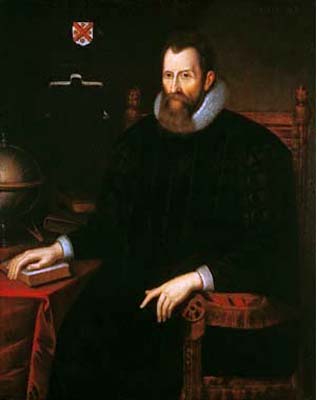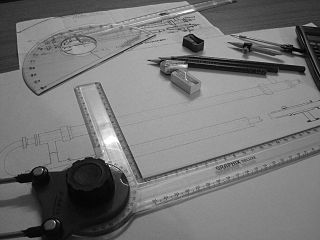Related Research Articles
The decibel is a relative unit of measurement equal to one tenth of a bel (B). It expresses the ratio of two values of a power or root-power quantity on a logarithmic scale. Two signals whose levels differ by one decibel have a power ratio of 101/10 or root-power ratio of 101⁄20.

ISO 216 is an international standard for paper sizes, used around the world except in North America and parts of Latin America. The standard defines the "A", "B" and "C" series of paper sizes, including A4, the most commonly available paper size worldwide. Two supplementary standards, ISO 217 and ISO 269, define related paper sizes; the ISO 269 "C" series is commonly listed alongside the A and B sizes.

John Napier of Merchiston., nicknamed Marvellous Merchiston, was a Scottish landowner known as a mathematician, physicist, and astronomer. He was the 8th Laird of Merchiston. His Latinized name was Ioannes Neper.

The neper is a logarithmic unit for ratios of measurements of physical field and power quantities, such as gain and loss of electronic signals. The unit's name is derived from the name of John Napier, the inventor of logarithms. As is the case for the decibel and bel, the neper is a unit defined in the international standard ISO 80000. It is not part of the International System of Units (SI), but is accepted for use alongside the SI.

A logarithmic scale is a way of displaying numerical data over a very wide range of values in a compact way. As opposed to a linear number line in which every unit of distance corresponds to adding by the same amount, on a logarithmic scale, every unit of length corresponds to multiplying the previous value by the same amount. Hence, such a scale is nonlinear. In nonlinear scale, the numbers 1, 2, 3, 4, 5, and so on would not be equally spaced. Rather, the numbers 10, 100, 1000, 10000, and 100000 would be equally spaced. Likewise, the numbers 2, 4, 8, 16, 32, and so on, would be equally spaced. Often exponential growth curves are displayed on a log scale, otherwise they would increase too quickly to fit within a small graph.

A vehicle identification number (VIN) (also called a chassis number or frame number) is a unique code, including a serial number, used by the automotive industry to identify individual motor vehicles, towed vehicles, motorcycles, scooters and mopeds, as defined by the International Organization for Standardization in ISO 3779 (content and structure) and ISO 4030 (location and attachment).

Film speed is the measure of a photographic film's sensitivity to light, determined by sensitometry and measured on various numerical scales, the most recent being the ISO system introduced in 1974. A closely related system, also known as ISO, is used to describe the relationship between exposure and output image lightness in digital cameras. Prior to ISO, the most common systems were ASA in the U.S. and DIN in Europe.

The phon is a logarithmic unit of loudness level for tones and complex sounds. Loudness is measured in sones, a linear unit. Human sensitivity to sound is variable across different frequencies; therefore, although two different tones may present an identical sound pressure to a human ear, they may be psychoacoustically perceived as differing in loudness. The purpose of the phon is to provide a logarithmic measurement for perceived sound magnitude, while the primary loudness standard methods result in a linear representation. A sound with a loudness of 1 sone is judged equally loud as a 1 kHz tone with a sound pressure level of 40 decibels above 20 micropascal. The phon is psychophysically matched to a reference frequency of 1 kHz. In other words, the phon matches the sound pressure level (SPL) in decibels of a similarly perceived 1 kHz pure tone. For instance, if a sound is perceived to be equal in intensity to a 1 kHz tone with an SPL of 50 dB, then it has a loudness of 50 phons, regardless of its physical properties. The phon was proposed in DIN 45631 and ISO 532 B by Stanley Smith Stevens.

In mathematics, the binary logarithm is the power to which the number 2 must be raised to obtain the value n. That is, for any real number x,
In compiler construction, strength reduction is a compiler optimization where expensive operations are replaced with equivalent but less expensive operations. The classic example of strength reduction converts strong multiplications inside a loop into weaker additions – something that frequently occurs in array addressing.(Cooper, Simpson & Vick 1995, p. 1)
In industrial design, preferred numbers are standard guidelines for choosing exact product dimensions within a given set of constraints. Product developers must choose numerous lengths, distances, diameters, volumes, and other characteristic quantities. While all of these choices are constrained by considerations of functionality, usability, compatibility, safety or cost, there usually remains considerable leeway in the exact choice for many dimensions.

Gautrain is an 80-kilometre (50-mile) higher-speed express commuter rail system in Gauteng, South Africa, which links Johannesburg, Pretoria, Kempton Park and O. R. Tambo International Airport. It takes 15 minutes to travel from Sandton to O. R. Tambo International Airport on the Gautrain and 35 minutes from Pretoria in Tshwane to Park Station in Johannesburg. The Gautrain has 10 stations. Buses, shuttles and midibus services are available to transport passengers to and from all stations excluding the O. R. Tambo International Airport Station.
The ISO metric screw thread is the most commonly used type of general-purpose screw thread worldwide. They were one of the first international standards agreed when the International Organization for Standardization (ISO) was set up in 1947.

The Toyota LiteAce and TownAce are a line of light commercial and derivative passenger vans produced by the Japanese car manufacturer Toyota. These vehicles originally utilized the cab-over-engine configuration, although since 1996 a semi-cab-over arrangement has featured instead. The LiteAce launched in 1970 as light-duty truck, with commercial and van/wagon body variants added in 1971. In 1976, Toyota released the larger TownAce van/wagon that derived from the LiteAce; a TownAce truck arrived later in 1978. Between 1982 and 1992, the series accommodated the MasterAce Surf—an upscale TownAce passenger wagon.
R17 or R-17 may refer to:

North Ipswich Railway Workshops is a heritage-listed former Australian railway workshop at North Street, North Ipswich, Queensland. It was built from 1878 to 1980s. It is also known as the Workshops Rail Museum. It was added to the Queensland Heritage Register on 21 April 1997.

The E series is a system of preferred numbers derived for use in electronic components. It consists of the E3, E6, E12, E24, E48, E96 and E192 series, where the number after the 'E' designates the quantity of logarithmic value "steps" per decade. Although it is theoretically possible to produce components of any value, in practice the need for inventory simplification has led the industry to settle on the E series for resistors, capacitors, inductors, and zener diodes. Other types of electrical components are either specified by the Renard series or are defined in relevant product standards.
The Australian Football League celebrates the best mark of the season through the annual Mark of the Year competition. In 2017, this is officially known as the Woolworths AFL Mark of the Year. Each round three marks are nominated and fans are able to vote online for their favourite. The winner was Essendon's Joe Daniher, which surprised many fans and media personal who expected Jeremy Howe of Collingwood to win the award for his screamer against Melbourne in round 12. Following the shock win, Collingwood's president Eddie McGuire said that the voting system for Mark of the Year needs an overhaul.

Preferred metric sizes are a set of international standards and de facto standards that are designed to make using the metric system easier and simpler, especially in engineering and construction practices. One of the methods used to arrive at these preferred sizes is the use of preferred numbers and convenient numbers, such as the Renard series and 1-2-5 series, to limit the number of different sizes of components needed.
References
- 1 2 ISO 3:1973-04 - Preferred Numbers - Series of Preferred Numbers. International Standards Organization (ISO). April 1973. Retrieved 2016-12-18. (Replaced: ISO Recommendation R3-1954 - Preferred Numbers - Series of Preferred Numbers. July 1954. (July 1953))
- ↑ Kienzle, Otto Helmut [in German] (2013-10-04) [1950]. Written at Hannover, Germany. Normungszahlen [Preferred numbers]. Wissenschaftliche Normung (in German). Vol. 2 (reprint of 1st ed.). Berlin / Göttingen / Heidelberg, Germany: Springer-Verlag OHG. ISBN 978-3-642-99831-7 . Retrieved 2017-11-01. (340 pages)
- ↑ Paulin, Eugen (2007-09-01). Logarithmen, Normzahlen, Dezibel, Neper, Phon - natürlich verwandt! [Logarithms, preferred numbers, decibel, neper, phon - naturally related!](PDF) (in German). Archived (PDF) from the original on 2016-12-18. Retrieved 2016-12-18.
- 1 2 "preferred numbers". Sizes, Inc. 2014-06-10 [2000]. Archived from the original on 2017-11-01. Retrieved 2017-11-01.
- ↑ ISO 17:1973-04 - Guide to the use of preferred numbers and of series of preferred numbers. International Standards Organization (ISO). April 1973. Archived from the original on 2017-11-02. Retrieved 2017-11-02.
[…] Preferred numbers were first utilized in France at the end of the nineteenth century. From 1877 to 1879, Captain Charles Renard, an officer in the engineer corps, made a rational study of the elements necessary in the construction of […] aircraft. He computed the specifications […] according to a grading system […]. Recognizing the advantage to be derived from the geometrical progression, he adopted […] a grading system […] that would yield a tenth multiple of the value […] after every fifth step of the series […] Renard's theory was to substitute […] more rounded but […] practical values […] as a power of 10, positive, nil or negative. He thus obtained […] 10 16 25 40 63 100 […] continued in both directions […] by the symbol R5 […] the R10, R20, R40 series were formed, each adopted ratio being the square root of the preceding one […] The first standardization drafts were drawn up on these bases in Germany by the Normenausschuss der Deutschen Industrie on 13 April 1920, and in France by the Commission permanente de standardisation in document X of 19 December 1921. […] the commission of standardization in the Netherlands proposed their unification […] reached in 1931 […] in June 1932, the International Federation of the National Standardizing Associations organized an international meeting in Milan, where the ISA Technical Committee 32, Preferred numbers, was set up and its Secretariat assigned to France. On 19 September 1934, the ISA Technical Committee 32 held a meeting in Stockholm; sixteen nations were represented: Austria, Belgium, Czechoslovakia, Denmark, Finland, France, Germany, Hungary, Italy, Netherlands, Norway, Poland, Spain, Sweden, Switzerland, U.S.S.R. With the exception of the Spanish, Hungarian and Italian […] the other delegations accepted the draft […] Japan communicated […] its approval […] the international recommendation was laid down in ISA Bulletin 11 (December 1935). […] After the Second World War, the work was resumed by ISO. The Technical Committee ISO/TC 19, Preferred numbers, was set up and France again held the Secretariat. This Committee at its first meeting […] in Paris in July 1949 […] recommended […] preferred numbers defined by […] ISA Bulletin 11, […] R5, R10, R20, R40. This meeting was attended by […] 19 […] nations: Austria, Belgium, Czechoslovakia, Denmark, Finland, France, Hungary, India, Israel, Italy, Netherlands, Norway, Poland, Portugal, Sweden, Switzerland, United Kingdom, U.S.A., U.S.S.R. During […] subsequent meetings in New York in 1952 and […] the Hague in 1953, […] attended also by Germany, […] series R80 was added […] The draft thus amended became ISO Recommendation R3. […]
(Replaced: ISO Recommendation R17-1956 - Preferred Numbers - Guide to the Use of Preferred Numbers and of Series of Preferred Numbers. 1956. (1955) and ISO R17/A1-1966 - Amendment 1 to ISO Recommendation R17-1955. 1966.) - ↑ De Simone, Daniel V. (July 1971). U.S. Metric Study Interim Report - Engineering Standards (PDF). Washington, USA: The National Bureau of Standards (NBS). NBS Special Publication 345-11 (Code: XNBSA). Archived (PDF) from the original on 2017-11-03. Retrieved 2017-11-03.
{{cite book}}:|website=ignored (help)